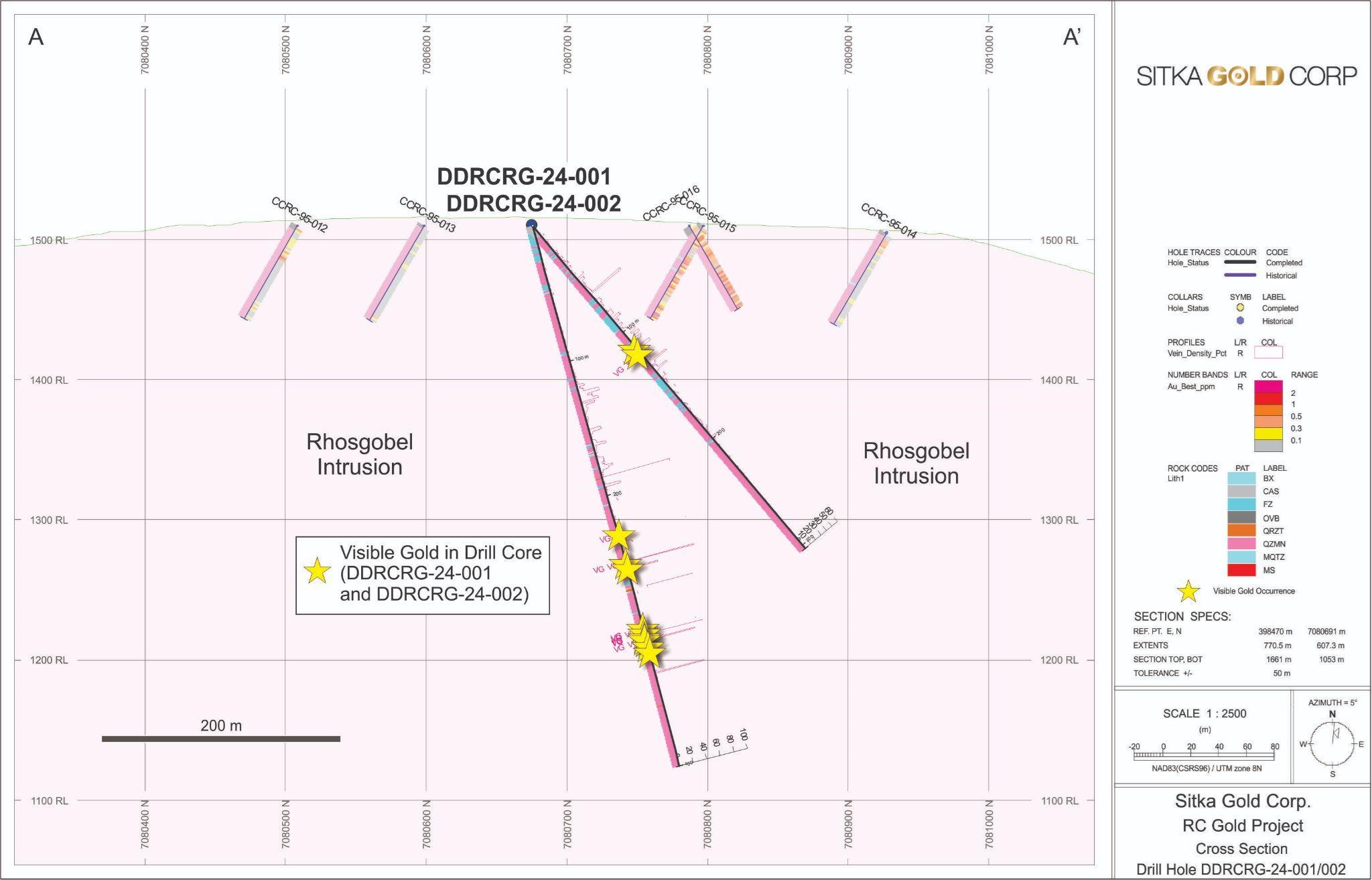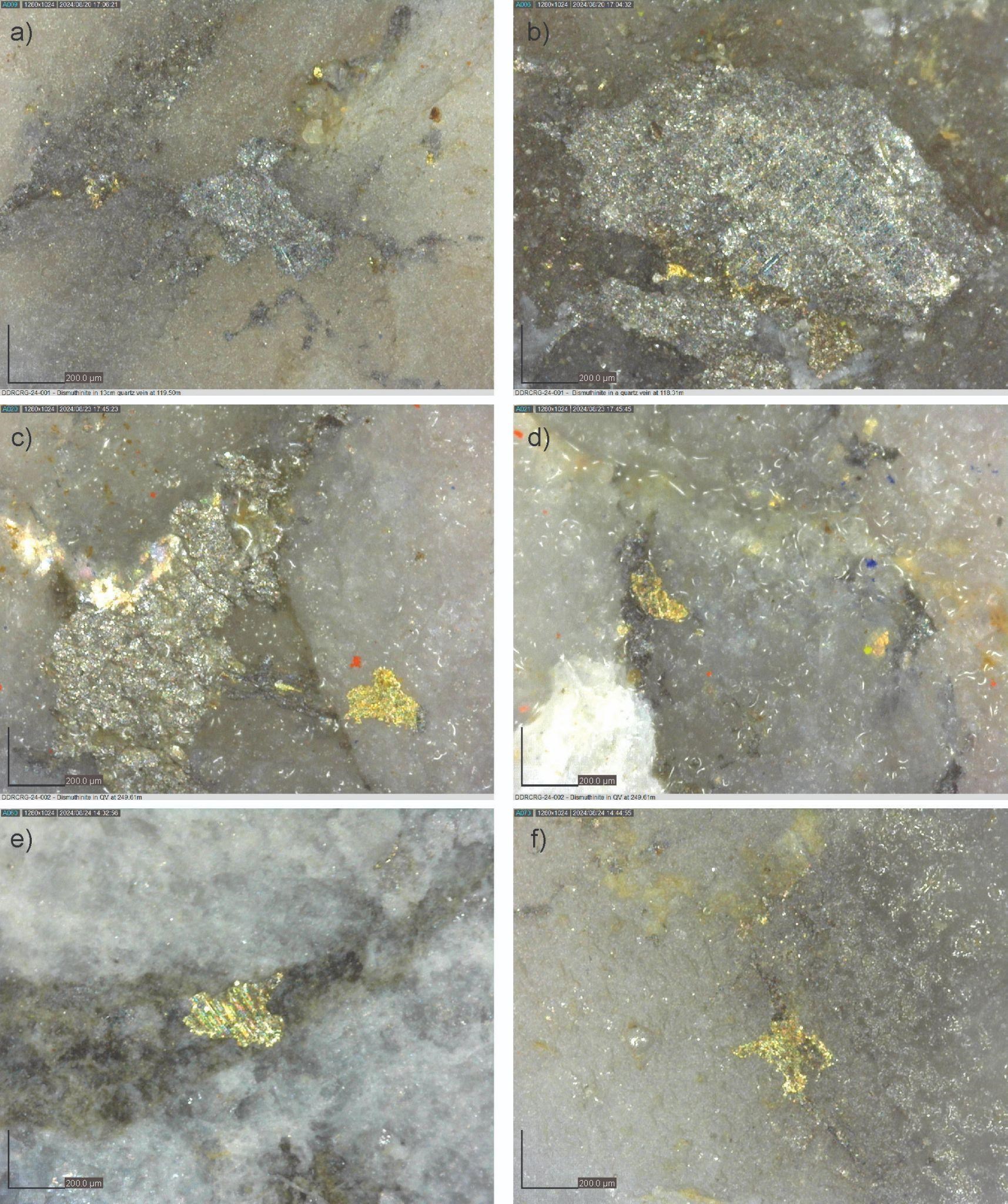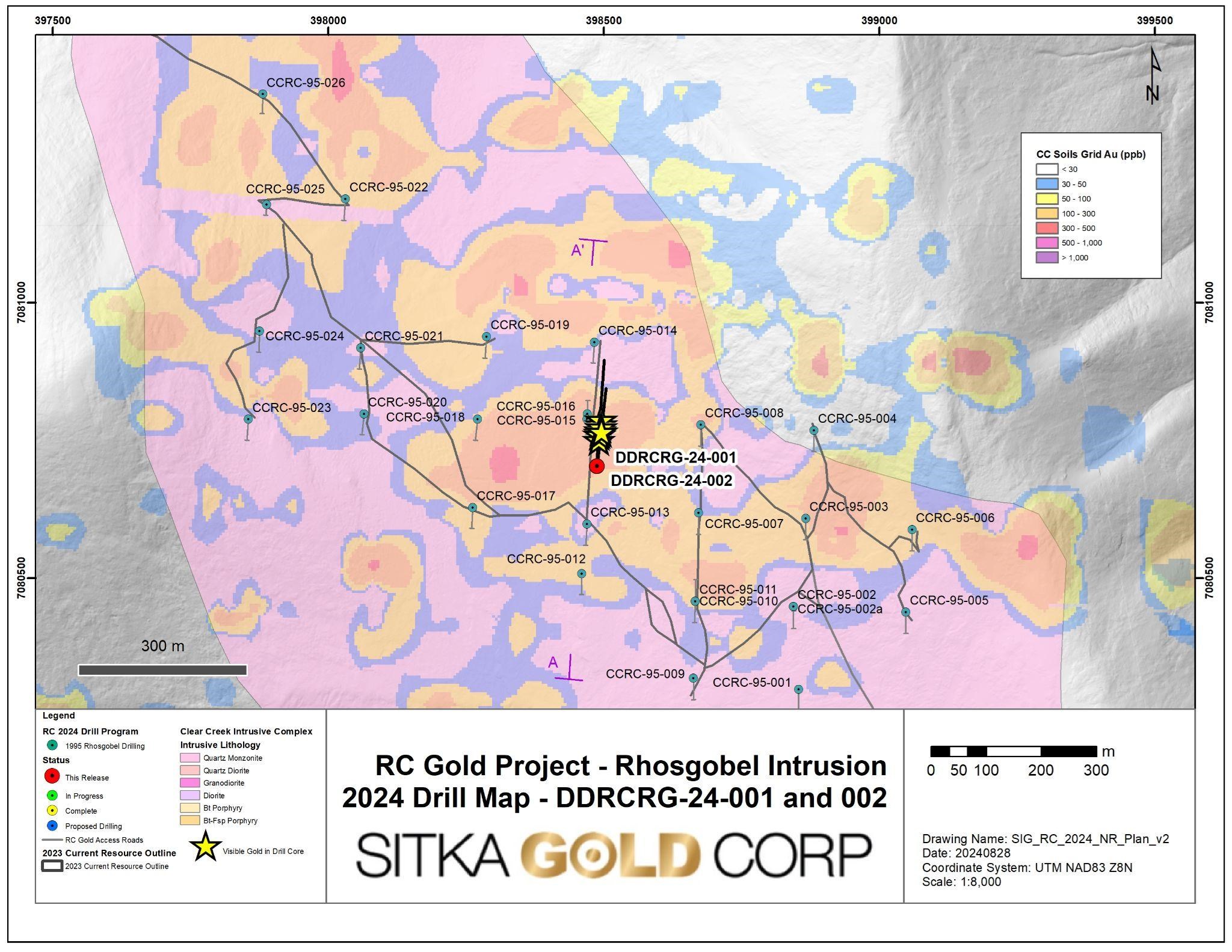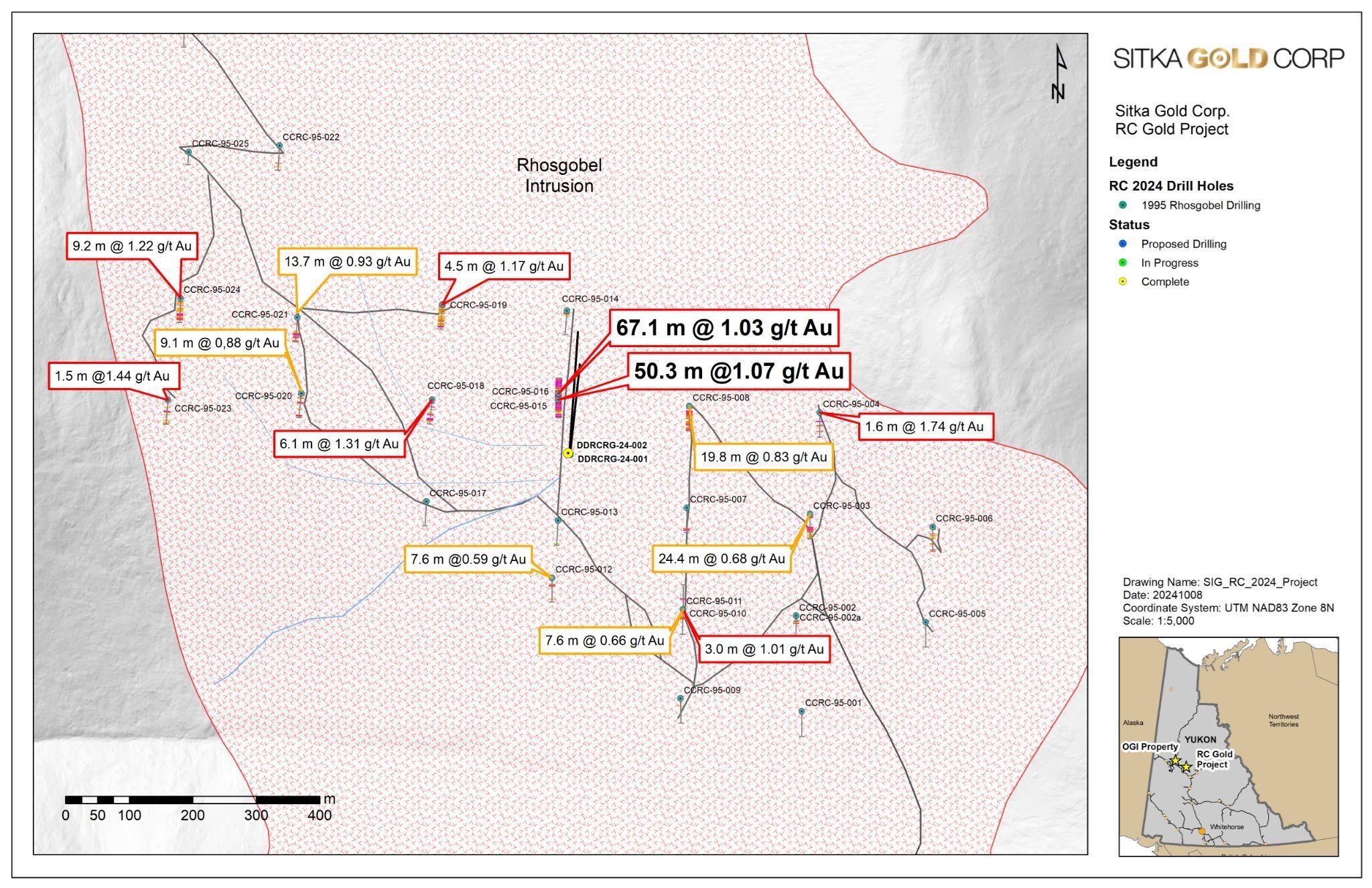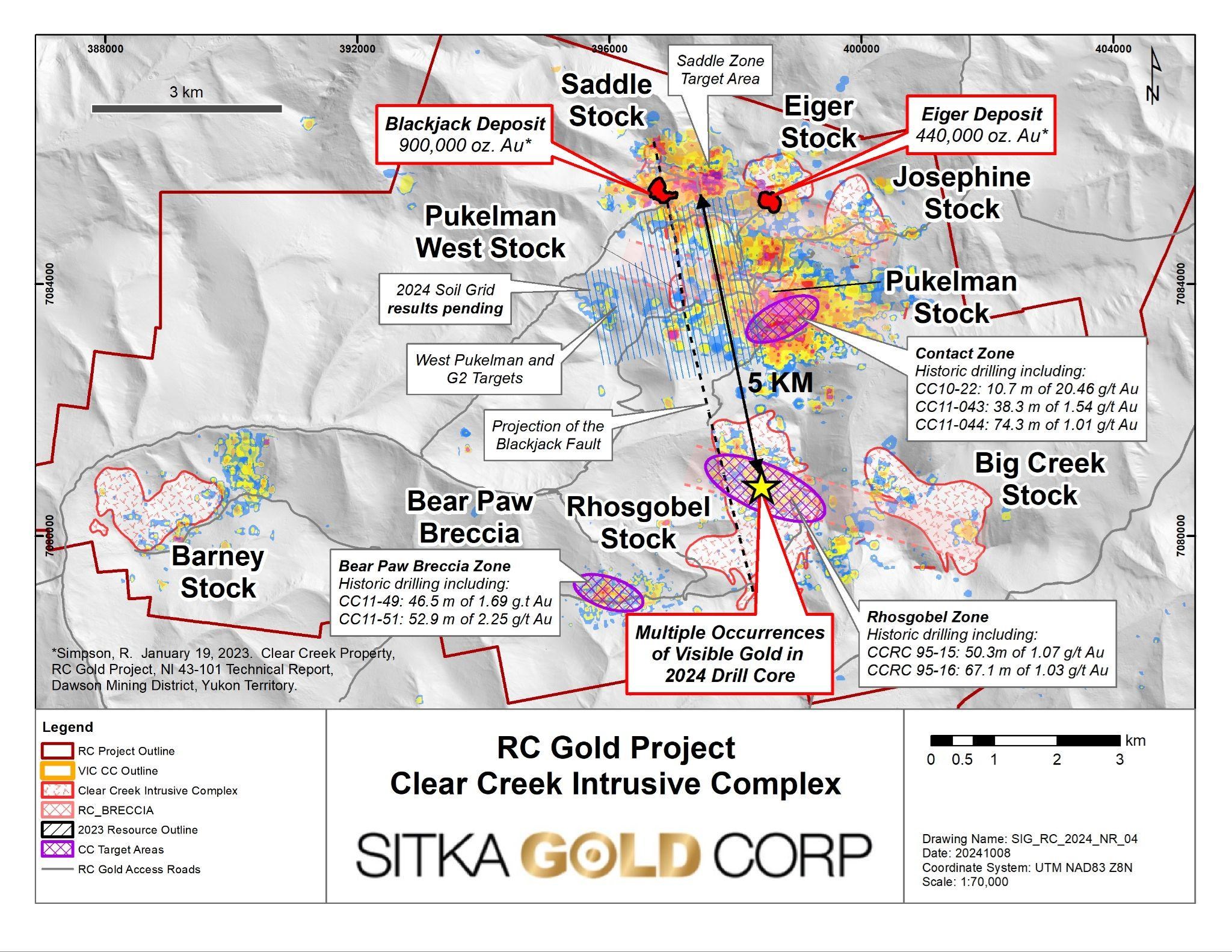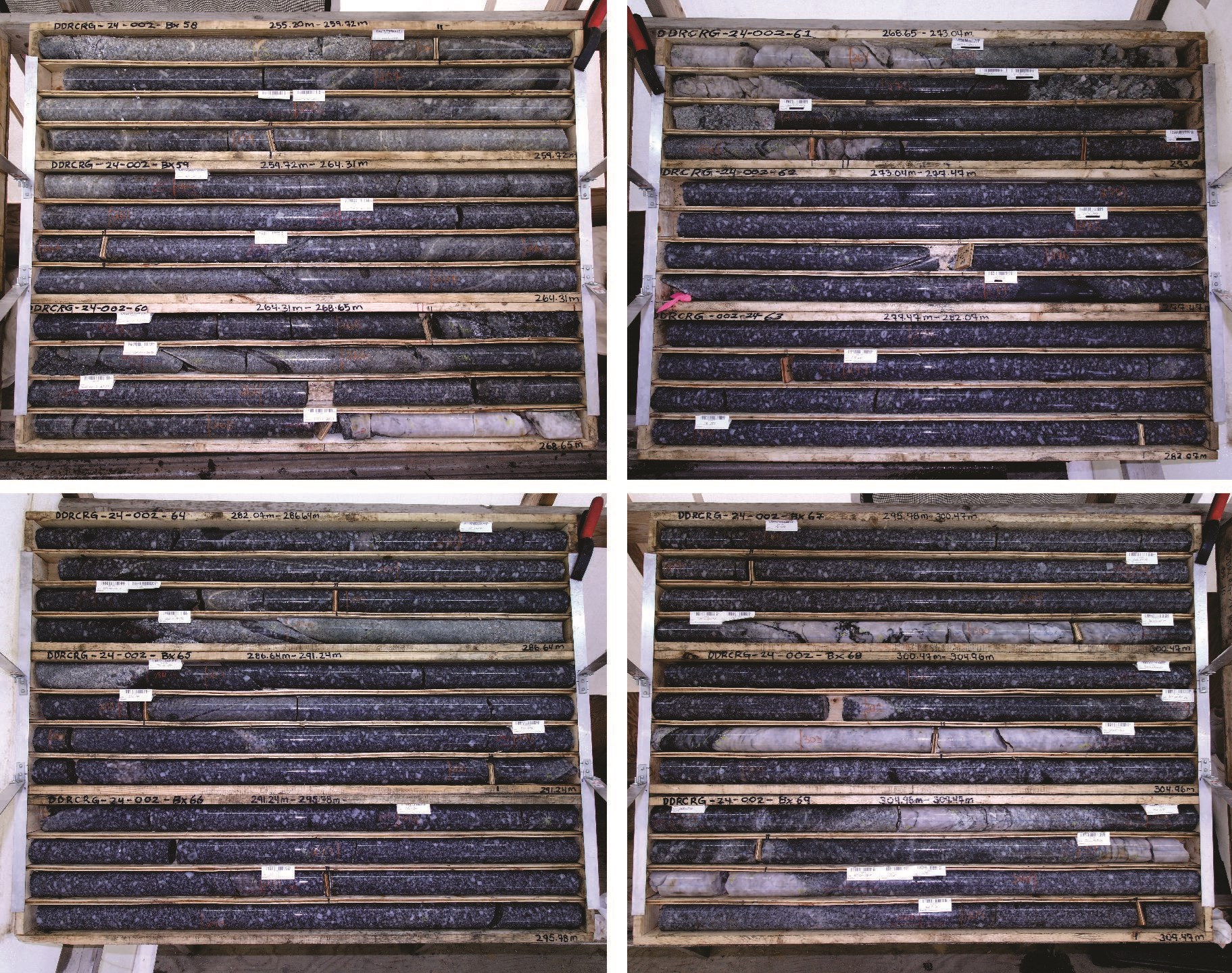Sitka Gold Encounters Multiple Observations of Visible Gold in First Two Diamond Drill Holes Ever Completed at the Rhosgobel Intrusion at Its Flagship RC Gold Project in Yukon
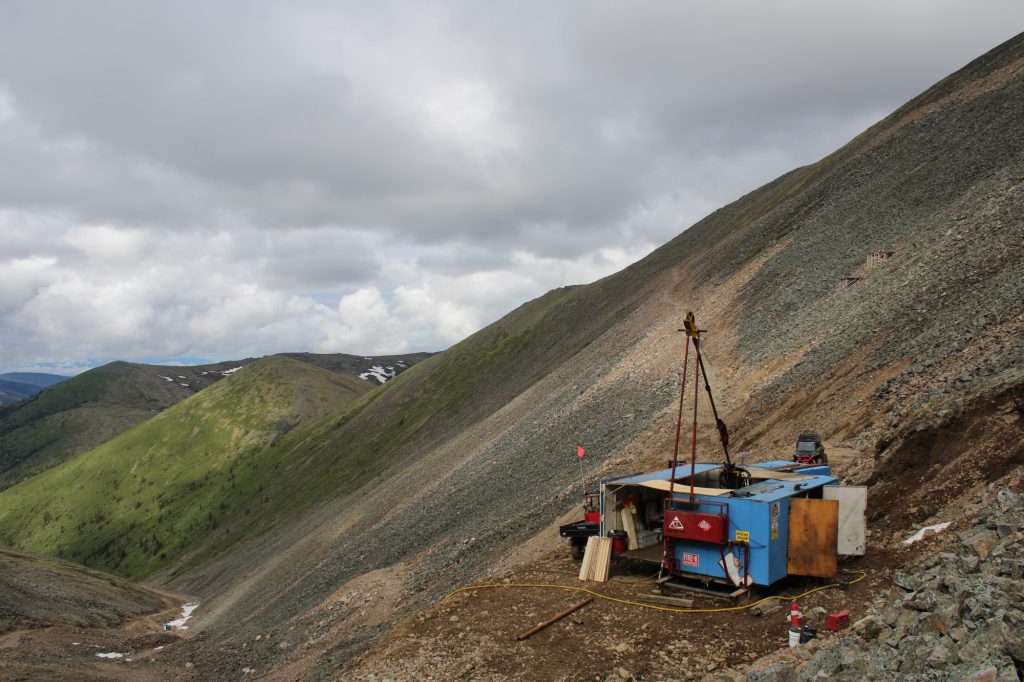
- Multiple instances of visible gold observed in drill core from first diamond drill holes ever completed at the Rhosgobel reduced intrusion-related gold deposit target located 5 km south of the Blackjack gold deposit.
- Gold mineralization appears to extend at least 250 metres below the extent of historical drilling.
- Large zones of reduced intrusion-related sheeted veins and breccias intersected below historical drilling.
- 11 instances of visible gold observed in hole DDRCRG-24-002.
Sitka Gold Corp. (TSXV: SIG) (FSE: 1RF) (OTCQB: SITKF) (“Sitka” or the “Company”)is pleased to announce that several instances of visible gold have been observed in the first two diamond drill holes ever completed at the Rhosgobel reduced intrusion-related gold deposit target, located approximately 5 kilometres south of the Blackjack gold deposit, at its year-round road accessible RC Gold Project in Yukon. The 2024 drilling at Rhosgobel suggests that gold mineralization continues for at least 250 metres beyond the depth of previous reverse circulation drilling that had ended in mineralization at a depth of 70 metres. Assay results for these drill holes are pending. The Company currently has two drills operating at its RC Gold property and is awaiting analytical results for other completed drill holes, including drill hole DDRCCC-24-068, which returned over 40 instances of visible gold from near surface (4 metres) to 680 metres depth (see news release dated September 11, 2024).
Figure 1 – A cross section of the 2024 drilling on the Rhosgobel intrusion showing the locations of visible gold observed in the drill core.
Figure 2 – Examples of instances of visible gold observed throughout DDRCRG-24-001 (a – b) and DDRCRG-24-002 (c – f). Visible gold is often associated with bismuthinite, scheelite, and arsenopyrite. Assays for these drill holes are currently pending.
“The visuals of the first two diamond drill holes to ever be completed at the Rhosgobel intrusion-related gold target (Figures 1, 2, 3 and 6) have exceeded expectations with several occurrences of visible gold observed in DDRCRG-24-001 and 002,” commented Cor Coe, CEO and Director of Sitka Gold. “The visual results from our first pass of drilling at Rhosgobel are very encouraging and highlight the significant potential of the many high-priority targets we have yet to drill within the Clear Creek Intrusive Complex (see Figure 5). We eagerly await the assays from these holes which suggest that robust gold mineralization continues from surface to a vertical depth at least 250 metres below the extent of historical drilling and showcase the potential for Rhosgobel to host another significant intrusion-related gold deposit within the Clear Creek Intrusive Complex analogous to our growing Blackjack deposit. Diamond drilling utilising oriented core at Rhosgobel has provided valuable information to Sitka’s technical team confirming the similar structural and geological controls on gold mineralization that occur at the Blackjack and Eiger deposits, located approximately 5 kilometres to the north, and the team is excited to apply the knowledge gained from our geological modelling to further advance this exciting target.”
The Rhosgobel intrusion is the largest and southernmost exposed intrusion that forms a part of the Clear Creek Intrusive Complex (CCIC). Intrusions within the CCIC occupy an area of approximately 8 by 15 kilometres and likely emanate from a common magmatic source at depth. The intrusions range in their compositions and include quartz monzonite, granodiorite and diorite. Felsic and lamprophyre dykes are also emplaced within the CCIC. All of the intrusions have known gold mineralization associated with them and form a large mineralized system with the potential to host several gold deposits. The Blackjack deposit is hosted within a quartz monzonite intrusion which contains megacrystic phases (big feldspar crystals). The Rhosgobel intrusion located 5 km to the south of the Blackjack deposit along the trend of the northerly striking Blackjack fault is of a similar composition.
Previous drilling in 1995 by Kennecott consisting of shallow reverse circulation drilling indicated widespread gold mineralization within the Rhosgobel intrusion (see Figure 4) and these initial drill holes indicate a much larger mineralized system with intersections of gold at much greater depths than the previous work.
Mineralization at Rhosgobel consists of abundant 1-2 cm sheeted quartz veins, larger (10-40 cm) quartz tourmaline veins, and large zones of quartz tourmaline breccias and stockwork within a larger zone cutting the feldspar megacrystic, quartz monzonite host intrusion. Abundant coarse scheelite and sulphides (including pyrrhotite and pyrite with subordinate arsenopyrite) occur within the veins and breccias throughout the intrusion. Gold was observed within the quartz veins and breccias and was consistently associated with bismuthinite, scheelite, and occasionally molybdenite. Alteration was pervasive quartz-sericite and sericite-chlorite alteration with more intense quartz-sericite-chlorite alteration selvages around the veins. Assays are pending for both drill holes.
DDRCRG-24-001
Drill hole DDRCRG-24-001 was drilled to a depth of 303.6 metres at a dip of -50 degrees and an azimuth of 10 degrees to test the down dip extension of the gold mineralization intersected in the historical RC drill holes CCRC-95-15 and CCRC-95-16. This hole intersected approximately 200 m of altered, faulted, brecciated, and mineralized feldspar megacrystic quartz monzonite and approximately 100 m of weakly altered quartz monzonite cut by occasional 1-10 cm quartz-scheelite sheeted veins. Visible gold was observed at 118.3 and 119.5 metres.
DDRCRG-24-002
Drill hole DDRCRG-24-002 was drilled to a depth of 400.8 metres at a dip of -75 degrees and an azimuth of 10 degrees to test the down dip extension of the gold mineralization intersected in the historical RC drill holes CCRC-95-15 and CCRC-95-16, and the mineralized interval intersected in DDRCRG-24-001. This hole intersected approximately 50 metres of oxidized, altered, faulted, and mineralized feldspar megacrystic quartz monzonite, then continued through bands of high vein density and very large quartz veins with strong alteration around them, in the same rock with faulting and mineralization including coarse scheelite, and not uncommonly molybdenite, and bismuthinite. There was a massive sulphide layer bounded by quartz-sulphide breccias. Large quartz veins are commonly mildly brecciated with massive tourmaline veining. Visible gold was observed at 229.3, 249.6, 249.61, 299.5, 299.53, 299.66. 300.6, 303.11, 303.24, 303.38, 307.4 metres.
Figure 3 – Plan map of the 2024 drilling on the Rhosgobel intrusion showing the locations of visible gold observed in the drill core along with the 1.5 x 2.0 kilometre gold-in-soil anomaly and mapped intrusion.
Figure 4 – Shallow reverse circulation drilling in the Rhosgobel intrusion in 1995 produced numerous intersections of gold mineralization consisting of sheeted quartz veins with megacrystic quartz monzonite. Holes 15 and 16 were drilled in opposite directions at 60 degrees dip intersected mineralization over their entire lengths. The holes intersected 50.3 m grading 1.07 g/t gold and 67.1m of 1.03 g/t gold respectively with both holes ending in mineralization.
Figure 5 – Map showing multiple priority target areas across the recently consolidated Clear Creek Intrusive Complex along with the location of 2024 diamond drilling completed at the Rhosgobel intrusion approximately 5 km south of the Blackjack and Eiger deposits. The Rhosgobel intrusion is approximately 3 km long and 2 km wide. Drilling is currently underway to test the projection of higher-grade gold mineralization along the newly identified Blackjack Mineralized Corridor that follows the Blackjack Fault and extends for over 10 kilometres through the Saddle, Pukelman West and Rhosgobel Intrusive Stocks. Higher-grade gold mineralization is modelled along intersections of structural corridors that form conduits for gold mineralization. A large mineral system highlighted by the numerous gold-bearing intrusions and intersecting structural corridors similar to that being defined at the Blackjack Deposit exist at many other target areas within the Clear Creek Intrusive Complex.
Figure 6 – Core photos of 2024 diamond drilling showing the mineralization at Rhosgobel consisting of sheeted quartz veins, quartz-tourmaline veins, and quartz-tourmaline breccias cutting megacrystic quartz monzonite.
About the flagship RC Gold Project
The RC Gold Project consists of a 431 square kilometre contiguous district-scale land package located in the heart of Yukon’s Tombstone Gold Belt. The project is located approximately 100 kilometres east of Dawson City, which has a 5,000 foot paved runway, and is accessed via a secondary gravel road from the Klondike Highway which is usable year-round and is an approximate 2 hour drive from Dawson City. It is the largest consolidated land package strategically positioned mid-way between the Eagle Gold Mine and the past producing Brewery Creek Gold Mine.
On January 19, 2023 Sitka Gold announced an Initial Mineral Resource Estimate prepared in accordance with National Instrument 43-101 (“NI 43-101”) guidelines for the RC Gold Property of 1,340,000 ounces of gold(1). The road accessible, pit constrained Mineral Resource is classified as inferred and is contained in two zones: The Blackjack and Eiger deposits with 900,000 ounces of gold grading 0.83 g/t and 440,000 ounces of gold grading 0.68 g/t respectively. Both of these deposits are at/near surface, are potentially open pit minable and amenable to heap leaching, with initial bottle roll tests indicating that the gold is not refractory and has high gold recoveries of up to 94% with minimal NaCN consumption (see News Release July 13, 2022). The Mineral Resource estimate is presented in the following table at a base case cut-off grade of 0.25 g/t Au:
RC Gold Inferred Mineral Resource Estimate
| COG g/t Au | Blackjack Zone | Eiger Zone | Combined | ||||||||
| Tonnes 000’s |
Au g/t | 0z Au 000’s |
Tonnes 000’s |
Au g/t | 0z Au 000’s |
Tonnes 000’s |
Au g/t | 0z Au 000’s |
|||
| 0.20 | 35,798 | 0.80 | 921 | 32,523 | 0.45 | 471 | 68,321 | 0.63 | 1,391 | ||
| 0.25 | 33,743 | 0.83 | 900 | 27,362 | 0.50 | 440 | 61,105 | 0.68 | 1,340 | ||
| 0.30 | 31,282 | 0.88 | 885 | 22,253 | 0.55 | 393 | 53,535 | 0.74 | 1,279 | ||
| 0.35 | 29,065 | 0.92 | 860 | 17,817 | 0.60 | 344 | 46,882 | 0.80 | 1,203 | ||
| 0.40 | 26,975 | 0.96 | 833 | 14,506 | 0.66 | 308 | 41,481 | 0.86 | 1,140 | ||
Notes
1. Mineral resource estimate prepared by Ronald G. Simpson of GeoSim Services Inc. with an effective date of January 19, 2023. Mineral Resources are classified using the 2014 CIM Definition Standards.
2. The cut-off grade of 0.25 g/t Au is believed to provide a reasonable margin over operating and sustaining costs for open-pit mining and processing
3. Mineral resources are constrained by an optimised pit shell using the following assumptions: US$1800/oz Au price; a 45° pit slope; assumed metallurgical recovery of 85%; mining costs of US$2.00 per tonne; processing costs of US$8.00 per tonne; G&A of US$1.50/t.
4. Mineral resources are not mineral reserves and do not have demonstrated economic viability.
5. Totals may not sum due to rounding.
To date, 72 diamond drill holes have been drilled into this system by the Company for a total of approximately 25,136 metres. The initial resource was based on 11,630 m of drilling in 34 holes with 22 holes totaling 7,492 m in the Blackjack deposit. Drilling since the initial resource release has focused on expanding the Blackjack resource with an additional 12-holes totaling 5,212 drilled in 2023 and 15-holes totaling 7162 m to date in 2024. Other targets drilled to date include the Saddle zone, Josephine zone and the Rhosgobel zone. The resource expansion drilling in 2023 at Blackjack produced results of up to 219.0 m of 1.34 g/t gold including 124.8 m of 2.01 g/t gold and 55.0 m of 3.11 g/t gold in drill hole DDRCCC-23-047 (see news release dated September 26, 2023) and in 2024 results of up to 290.5 m grading 1.10 g/t gold including 105.0 m of 1.68 g/t gold in DDRCC-24-062 (see news release dated August 19, 2024).
(1) Simpson, R. January 19, 2023. Clear Creek Property, RC Gold Project, NI 43-101 Technical Report, Dawson Mining District, Yukon Territory
RC Gold Deposit Model
Exploration on the Property has mainly focused on identifying an intrusion-related gold system (“IRGS”). The property is within the Tombstone Gold Belt which is the prominent host to IRGS deposits within the Tintina Gold Province in Yukon and Alaska. Notable deposits from the belt include: Fort Knox Mine in Alaska with current Proven and Probable Reserves of 230 million tonnes at 0.3 g/t Au (2.471 million ounces; Sims 2018)(1); Eagle Gold Mine with current Measured and Indicated Resources of 233 million tonnes at a grade of 0.57 g/t Au at the Eagle Main Zone (4.303 million ounces; Harvey et al, 2022)(2); the Brewery Creek deposit with current Indicated Mineral Resource of 22.2 million tonnes at a gold grade of 1.11 g/t (0.789 million ounces; Hulse et al. 2020)(3); the Florin Gold deposit, located adjacent to Sitka’s RC Gold project, with a current Inferred Mineral Resource of 170.99 million tonnes grading 0.45 g/t (2.47 million ounces; Simpson 2021)(4) and the AurMac Project with an Inferred Mineral Resource of 347.49 million tonnes grading 0.63 gram per tonne gold (7.00 million ounces)(5).
(1) Sims J. Fort Knox Mine Fairbanks North Star Borough, Alaska, USA National Instrument 43-101 Technical Report. June 11, 2018. https://s2.q4cdn.com/496390694/files/doc_downloads/2018/Fort-Knox-June-2018-Technical-Report.pdf
(2) Harvey N., Gray P., Winterton J., Jutras M., Levy M.,Technical Report for the Eagle Gold Mine, Yukon Territory, Canada. Victoria Gold Corp. December 31, 2022. https://vgcx.com/site/assets/files/6534/vgcx_-_2023_eagle_mine_technical_report_final.pdf
(3) Hulse D, Emanuel C, Cook C. NI 43-101 Technical Report on Mineral Resources. Gustavson Associates. May 31, 2020. https://minedocs.com/22/Brewery-Creek-PEA-01182022.pdf
(4) Simpson R. Florin Gold Project NI 43-101 Technical Report. Geosim Services Inc. April 21, 2021. https://sedar.com/GetFile.do?lang=EN&docClass=24&issuerNo=00005795&issuerType=03&projectNo=03236138&docI d=4984158
(5) Thornton T., Jutras M., Malhotra D. Technical Report Aurmac Property Mayo Mining District, Yukon Territory, Canada. JDS Energy and Mining Inc. February 6, 2024. https://banyangold.com/site/assets/files/5251/banyan_gold_ni_43-101_technical_report_2024_03_18.pdf
Upcoming Events
Sitka Gold will be attending and/or presenting at the following events*:
- Red Cloud Fall Mining Showcase, Toronto, Ontario: October 16 – 17, 2024
- Yukon Geoscience, Whitehorse, Yukon: November 17 – 20, 2024
- VRIC, Vancouver, BC: January 19 – 20, 2025
- RoundUp, Vancouver, BC: January 20-23, 2025
*All events are subject to change.
About Sitka Gold Corp.
Sitka Gold Corp. is a well-funded mineral exploration company headquartered in Canada with over $10 million in its treasury and no debt. The Company is managed by a team of experienced industry professionals and is focused on exploring for economically viable mineral deposits with its primary emphasis on gold, silver and copper mineral properties of merit. Sitka is currently drilling at its 100% owned, 431 square kilometre flagship RC Gold Project located within the Tombstone Gold Belt in the Yukon Territory. The Company is also advancing the Alpha Gold Project in Nevada and currently has drill permits for its Burro Creek Gold and Silver Project in Arizona and the Coppermine River Project in Nunavut.
The Company recently announced an NI 43-101 compliant initial inferred Mineral Resource Estimate of 1,340,000 ounces of gold(1) beginning at surface and grading 0.68 g/t at its RC Gold Project in Yukon (see news release dated January 19, 2023).
(1) Simpson, R. January 19, 2023. Clear Creek Property, RC Gold Project, NI 43-101 Technical Report, Dawson Mining District, Yukon Territory
*For more detailed information on the Company’s properties please visit our website at www.sitkagoldcorp.com
The scientific and technical content of this news release has been reviewed and approved by Cor Coe, P.Geo., Director and CEO of the Company, and a Qualified Person (QP) as defined by National Instrument 43-101.
ON BEHALF OF THE BOARD OF DIRECTORS OF
SITKA GOLD CORP.
“Donald Penner“
President and Director
For more information contact:
Donald Penner
President & Director
778-212-1950
dpenner@sitkagoldcorp.com
or
Cor Coe
CEO & Director
604-817-4753
ccoe@sitkagoldcorp.com
Neither TSX Venture Exchange nor its Regulation Services Provider (as that term is defined in policies of the TSX Venture Exchange) accepts responsibility for the adequacy or accuracy of this release.
Cautionary and Forward-Looking Statements
This release includes certain statements and information that may constitute forward-looking information within the meaning of applicable Canadian securities laws. Forward-looking statements relate to future events or future performance and reflect the expectations or beliefs of management of the Company regarding future events. Generally, forward-looking statements and information can be identified by the use of forward-looking terminology such as “intends” or “anticipates”, or variations of such words and phrases or statements that certain actions, events or results “may”, “could”, “should”, “would” or “occur”. This information and these statements, referred to herein as “forward‐looking statements”, are not historical facts, are made as of the date of this news release and include without limitation, statements regarding discussions of future plans, estimates and forecasts and statements as to management’s expectations and intentions and the Company’s anticipated work programs.
These forward‐looking statements involve numerous risks and uncertainties and actual results might differ materially from results suggested in any forward-looking statements. These risks and uncertainties include, among other things, market uncertainty and the results of the Company’s anticipated work programs.
Although management of the Company has attempted to identify important factors that could cause actual results to differ materially from those contained in forward-looking statements or forward-looking information, there may be other factors that cause results not to be as anticipated, estimated or intended. There can be no assurance that such statements will prove to be accurate, as actual results and future events could differ materially from those anticipated in such statements. Accordingly, readers should not place undue reliance on forward-looking statements and forward-looking information. Readers are cautioned that reliance on such information may not be appropriate for other purposes. The Company does not undertake to update any forward-looking statement, forward-looking information or financial out-look that are incorporated by reference herein, except in accordance with applicable securities laws. We seek safe harbor.

